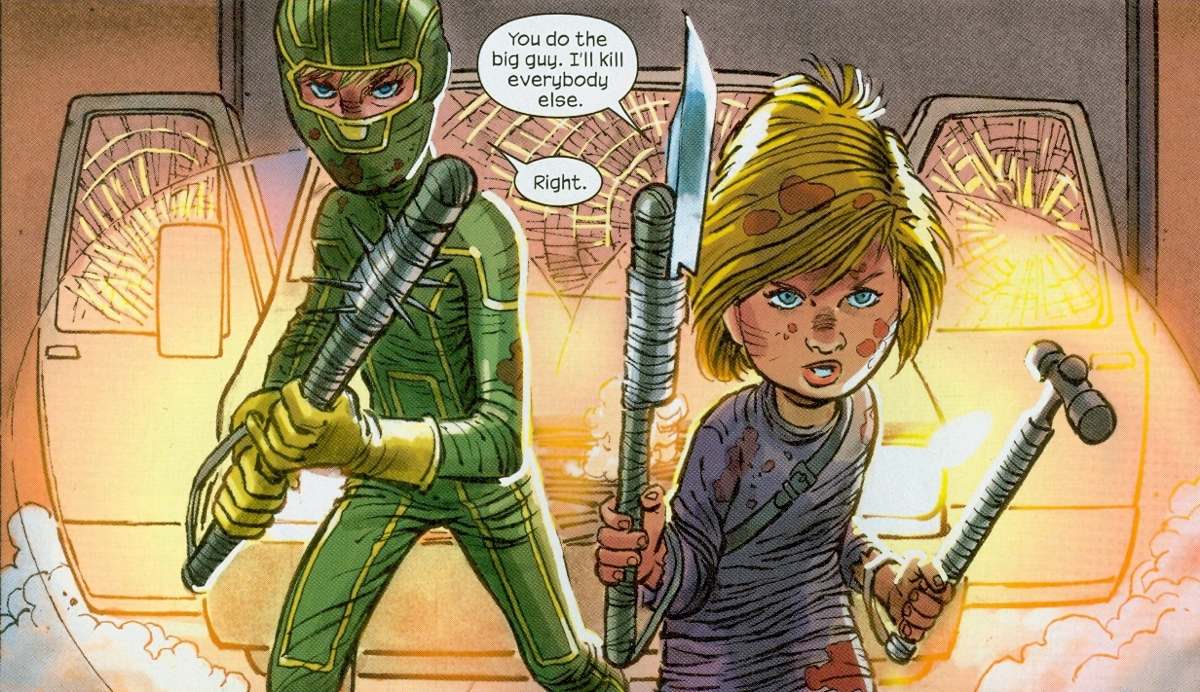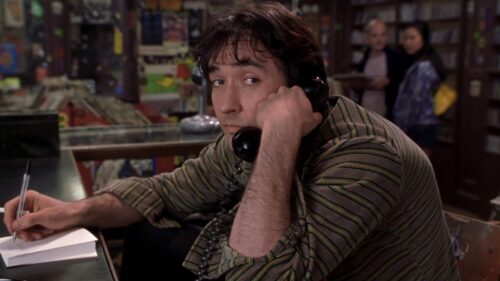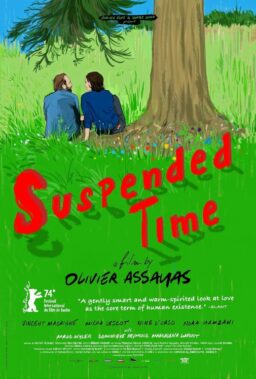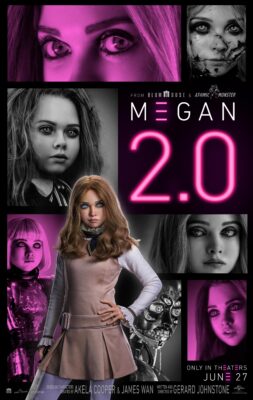The new film adaptation of “Kick-Ass 2” is a very medium-specific provocation. It’s based on a comic book by writer Mark Millar and artist John Romita Jr., a series that is one of a handful of bratty, pseudo-adult comics that were intended for “mature readers.” These comics tweak generic norms without fully deconstructing them. Apart from the serial use of cusswords, T&A, and bloody violence, comics like “Kick-Ass,” “Irredeemable,” and “Crossed” are all creator-owned properties, series that are not directly related to characters or stories released by major publishers like DC and Marvel Comics. They’re also all serial narratives that riff on what readers know and have come to associate with genres like superheroes and zombies/survival horror.
At the same time, none of these stories really break the respective narrative molds they’re based in. Instead, they stand out because they smart-assedly speculate what fantasy stories would be like in a real world designed by comics nerds. All three stories start by provocatively asserting that certain types of characters or situations would, in real life, be necessarily darker, more violent, and more prone to violence, sexual or otherwise, than readers’ formula-fed expectations would lead us to believe. But there’s the rub: these comics mostly exploit the extreme elements they use to differentiate themselves from their predecessors. They still peddle the same ol’, same ol’, only now with a bratty twist. Their creators wink at readers about how clichéd and psychologically simplistic our generic expectations are. Subversive they ain’t.
There are lots of SPOILERS ahead. You should know that. SPOILER!
Millar’s “Kick-Ass” and its sequel are the worst of these three examples. Millar’s zeal for provocation is simultaneously aggressive and consistently poorly executed. “Kick-Ass” and several of the other titles Millar has written under his Millarworld label directly address fanboy and comics nerd culture. In “Kick-Ass,” Dave Lizewski, a comic-obsessed 16-year-old, tries to boost his perilously low self-esteem by becoming a real-life superhero. Lizewski, a boy whose high school crush assumes he’s gay, lives in a world where superheroes only exist in comics. But as the audience’s surrogate, Dave is the butt of Millar’s jokes. His clueless single dad doesn’t know what he’s up to, and his costume is a Jack Kirby-inspired one-piece that makes him look like a deviant cosplayer.

Dave is on a hormone-hastened road to becoming Travis Bickle. The only things that burst his romantic bubble of what heroism is are other nuts pretending to be superheroes. These characters are only finitely disillusioning because, like Dave, they dream of being a hero as a means of overcompensating for their low self-esteem. There’s Big Daddy, the gun-toting kook who lies to Lizewski about why he’s a superhero, saying that he’s a clean cop in a corrupt town when in fact he’s a former accountant who arbitrarily/quixotically picks a fight with a big-time crime boss. Then there’s Hit-Girl, a foul-mouthed pre-teen who kills people without any remorse or mitigating conscience beyond black-and-white morality: the really bad guys die, and the mostly good guys live.
And then there’s Red Mist, another lonely teen who dons a costume after seeing a YouTube video of Dave thrashing and being thrashed by a gang of graffiti taggers. Red Mist eventually becomes disillusioned, and at the end of the first “Kick-Ass” comic, decides to become a villain, quoting Jack Nicholson’s Joker in the 1989 live-action “Batman” by growling, “Wait until they get a load of me.” All three of these characters give Dave a warped reflection of his desires, but none of them snap him out of his delusional ass-kicking calling.
In both “Kick-Ass” and its sequel, Millar refuses to choose between a strictly parodic or an earnest tone. This isn’t inherently a bad thing, and is to some extent a continuation of the types of comics he wrote before his Millarworld books. Before “Kick-Ass,” Millar wrote Judge Dredd stories for British publisher 2000 AD. After that came stories about The Authority, a fascistic counter to DC’s Justice League of America published by Wildstorm, an offshoot of DC’s main brand. They have power, are institutions unto themselves, and make rules on a whim. Kick-Ass is somewhat similar to those characters, except in Millar’s stories, nerds don’t become complex characters once they’ve got a little power. They’re still walking clichés, just with a greater propensity for doing or saying shocking things.
Millar only selectively bursts his characters’ bubbles, like in the ending of “Kick-Ass 2,” when the cops indiscriminately crack down on both superheroes and supervillains. For the majority of “Kick-Ass 2,” the story is fairly rote. Red Mist plots revenge against Kick-Ass; Hit-Girl hangs up her costume after making a promise to her emotionally frail step-mother; Kick-Ass joins a new team of disillusioned self-styled loser heroes. The story’s coloring scheme is noticeably lighter; the book is supposed to look deceptively straight-forward. But again, “Kick-Ass 2” is also peppered with glancing references to comics, and comics culture, like when one of Lizewski’s friends wonders aloud if lusting after Spiderman’s Aunt May is wrong, or another pines for cheesecake artist Adam Hughes’s pin-up art.
The problem with “Kick-Ass” and its attendant sequel is that Millar doesn’t really want his reader to relate or sympathize with Lizewski, just smirk at their own reflection, and revel in surface-deep satire. The main thing that separates his “Kick-Ass” stories from other superhero titles is their veneer of realism, and that’s really only when characters participate in acts of extremely graphic violence.
But funny-ugly violence gets shown, while serious violence we are menat to feel something about is not shown. We don’t see the implied rape of Lizewski’s unrequited crush and we don’t see the death of Lizewski’s dad.

But we do see a dog take a bloody bite out of a gangster’s crotch, and the decapitated head of that same dog stacked onto his headless owner’s shoulders. Likewise, Hit-Girl disappears for much of the story because it’s convenient, just as it’s convenient for Millar to fast-forward past the moments right after the death of Lizewski’s dad, where Lizewski dazedly remembers, in a few short asides, what he felt.
Millar’s interested in shock value, not character-driven moments. It’s telling that in the first issue of “Kick-Ass 2,” Lizewski complains that training with Hit-Girl makes him feel like “Rihanna on a quiet night in.” This is from the writer who ended “Wanted” by having antihero protagonist Wesley Gibson break the fourth wall, and splutter about how the reader is too afraid to admit they just want to enact their own power fantasies without scruples or a conscience. Gibson dreams of raping celebrities like Red Mist does in “Kick-Ass 2.” In the context of that book, Gibson’s liberated, so he talks down to Millar’s ideal reader: “This is my face when I’m f@#king you in the a%%.” “Kick-Ass 2” isn’t much more thoughtful, or intelligent than that kind of desperate provocation.
***
“Irredeemable” is less strident than “Kick-Ass” because it takes place in a world where superheroes are normal. It’s that normalcy that writer Mark Waid half-heartedly challenges. The series takes place in a world where the Plutonian, a nigh-omnipotent Superman-type hero, has an emotional breakdown, and goes on a rampage because he can’t take the pressures of saving the world anymore. Waid is a comics veteran who has years more experience writing superhero titles than Millar does, and his encyclopedic knowledge of characters is evident in “Irredeemable.” But like “Kick-Ass,” “Irredeemable” is based on a simplistic psychological reversal of expectations. It’s only provocative inasmuch as it takes character types that readers are familiar with, and puts them in immediately destabilizing situations. Bit by bit, one-note characters loosely based on DC and Marvel heroes and villains (ex: the Wonder Twins, Hawkman, Mr. Mxyzptlk, and Brainiac) reveal that their adventures and associations were never as light-hearted as they seemed.
Earlier comics stories, like Frank Miller’s “The Dark Knight Returns,” Alan Moore and Dave Gibbon’s “Watchmen,” and Moore’s brief revival of “Miracleman,” set a standard for this kind of deconstruction. But like “Kick-Ass,” “Irredeemable” has no life outside of the generic expectations it barely complicates. Waid’s characters are defined by psychological cliches, so nobody does anything you wouldn’t expect them to. There’s the scene in issue #5 where Volt, an African-American superhero with electricity-based powers, instinctively reverts to the jive-talking stereotypes he says he doesn’t conform to. So even though he laments, “Surprise, I’m a black super-hero with electrical powers. I know, I know,” he also exclaims, “sweet fudging monkeylover.”

There’s also the scene in issue #8 where the Plutonian goes on a rampage, and murders a group of scientist who tried to warn Samsara, the Plutonian’s boy sidekick, that the Plutonian was dangerous. He screams: “Stop it! Stop looking at me like I’m some bomb that could go off at any time! Is that what you think I am? Is that what you want me to be? Is it?” After annihilating everyone in the room, he mutters “Fine,” to himself, suggesting that the Plutonian is, to some extent, catering to our expectations. If it’s a vulnerable, dark Superman readers want, they can take the Plutonian and choke on him.
Unfortunately, the Plutonian’s rampage, and his former allies’s attempts to evade and take him down are just monotonous variations on a theme: everyone has a dirty secret, black is white, up is down, etc. Instead of going too far, Waid doesn’t go far enough in needling readers, preferring to cram his protagonists’ closets with skeletons instead of doing anything memorable with those figurative corpses. “Irredeemable” is consequently a dogpile of button-pushing shocks. First, we learn that the Plutonian killed his boy sidekick. Then he sinks all of Singapore, but only after sadistically killing three random people who privately grumbled that they don’t trust him. Then it’s revealed that the Plutonian had an affair with Bette Noir, a married member of Paradigm, the Plutonian’s former Justice League-esque teammates. Then there’s the revelation that the Plutonian used another superheroine, Encantra, as a sex slave, and dressed her up as Bette Noir. The Plutonian is also responsible for genocide. And he killed his abusive step-father, a Pa Kent-type figure, which led to his step-mom (i.e. Ma Kent) to kill herself just before he could save her. And on, and on, and on. The fact that Waid doesn’t consistently soak his series in blood doesn’t mitigate the fact that his series is ultimately toothless.
****
Thankfully, the first story arc of “Crossed,” written by Garth Ennis, and drawn by Jacen Burrows, is smart enough to offset the fact that it is just as exploitative as and even more gross than either “Kick-Ass” or “Irredeemable.” This is partly because Ennis is a more experienced provocateur than either Millar or Waid. Like Millar, Ennis has written several “Judge Dredd” stories. And before his successfully juvenile take on Marvel’s Punisher character, Ennis made an even bigger splash with “Preacher,” a grotesque picaresque story about a John Wayne-obsessed preacher who wants to make God pay for not caring about humanity anymore. “Crossed” starts out with a similarly nasty premise: what if the zombies that attacked people in a zombie crisis were God’s judgment on humanity? What if they weren’t just undead cannibals, but undead, foul-mouthed rapist cannibals because that’s all that people ultimately are?
While it’s not always successful, this first “Crossed” story arc (there have been several others, though none are as affecting or as focused) stridently undercuts readers’ romantic expectations for a survival horror series. Ennis mercilessly subverts our expectations throughout, baiting readers by giving them what he thinks they want, and then taking it away from them. Thomas, a young man who dotes on Stacy, a blind survivor, is not interested in her because he’s gay. Stan, the audience’s nerdy surrogate, also doesn’t make it with Cindy, the frigid Latina single mom he pines for throughout.
There is no cure for the Crossed. Moreover, Stan and Cindy’s story has no resolution save for the knowledge that the characters are now alone, and have to keep surviving after killing six kids, and, in Cindy’s case, her own son. Everything we know and want to believe about the characters in “Crossed” is wrong, as is bluntly established when a cavalier “fanboy” tries to stop the Crossed with a circle of table salt, and winds up being brutally gutted, and sodomized. In that sense, Ennis does what Millar and Waid try and fail to do: take established tropes, and brutishly manipulate them without fully breaking them down.

The Crossed zombies are, in Ennis’s estimation, humanity at their most vile. It’s also what Ennis is openly selling. Variant covers offer Bosch-ian displays of murder and torture. In fact, in addition to offering covers that are functionally labeled as “Wrap-Around” variants, Avatar, the book’s publisher, also offer a sub-genre of covers that are frankly called “Torture” covers. Ennis isn’t coy about the fact that he’s writing a more confrontational version of “The Walking Dead.” His gross-out sense of humor is often unbearable, as with the Crossed that attacks his victims with a rotting horse penis, or the wailing paraplegic Crossed that looks like a pinhead from a carnival sideshow.
But Ennis does know that he periodically needs to pull some of his punches. He particularly nails the ending, in which he unequivocally insists that hell is not knowing what comes next. Before Stan and Cindy forge on without other human companions, he projects, “So we walked down the hill into all those fears and maybes, all that sorrow, nothing certain in our lives except the frozen earth beneath our feet.” Ennis may only be selectively sincere, but making “Crossed” end with a more abstract kind of torture is the best rug-pulling prank he could have pulled.












